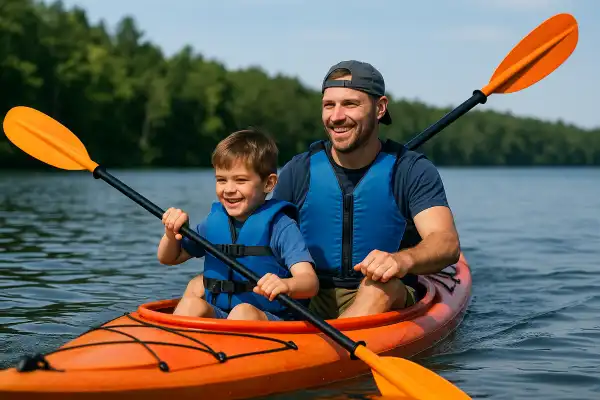Can you kayak camp with kids? This question surfaces frequently in paddling forums and around campfires, usually from parents torn between their love of wilderness camping and concerns about taking children on overnight water expeditions. During my decade of guiding families through New England’s backcountry waterways, I’ve witnessed countless parents wrestling with this exact dilemma.
Last spring, while teaching a family skills clinic at a quiet Vermont lake, I watched a father nervously adjust his 8-year-old daughter’s life vest for the fifth time before their first tandem paddle. That same weekend, she was confidently helping set up their waterfront campsite and begging for “just one more paddle” before bedtime.
Can you kayak camp with kids?
Yes, you absolutely can kayak camp with kids, and it can be one of the most rewarding outdoor experiences your family will share. The great thing about kayaking and camping is that they’re both family-friendly activities, and when combined thoughtfully, they create opportunities for deep connection away from digital distractions. Typically, children ages 4 to 7 will do fine sitting in the bow of a kayak but will not provide much propulsion, while kids 8 and older can begin taking more active paddling roles.

The key lies in proper planning, realistic expectations, and prioritizing safety above adventure. Unlike adult-only expeditions where you might push boundaries or paddle longer distances, family kayak camping requires a different mindset focused on building confidence, skills, and positive memories.
Age considerations for kayak camping
Understanding developmental stages helps determine the best approach for your family’s first kayak camping adventures. Children 8 and younger are probably going to be beginners, and between ages 8-10 they can start getting comfortable helping paddle in a tandem kayak, and eventually move into their own small boat.
For children under 5, consider them passengers rather than paddlers. They can ride in the center compartment of larger kayaks or sit in the bow of a tandem while you handle navigation and propulsion. If you have young kids (below 5 years), a great starting point is riding in the center compartment as onlookers. This arrangement lets them experience the water while remaining safe and secure.
Children aged 5-8 represent the sweet spot for beginning family kayak camping. They’re old enough to follow safety instructions, help with simple camp tasks, and paddle effectively in the bow position of tandem kayaks. By the time children are about 8 years of age, many are ready to paddle the bow of either a kayak or canoe.
Kids 8 and older can begin developing real paddling skills and taking on camp responsibilities. Some experienced 10-12 year olds may handle their own kayaks on calm water with close supervision, though all children under age 12 must paddle in a tandem kayak with an adult for most guided operations.
Essential safety protocols
Safety forms the foundation of successful family kayak camping, requiring more preparation than adult-only trips. PFD’s, light, breathable clothing, adequate food and water supplies, SPF, and a fleshed-out travel plan are all still applicable kayak safety measures you’ll implement with children.
Properly fitted personal flotation devices remain non-negotiable for every family member. PFDs are sized for infants (8-30 lbs.), children (30-50 lbs.) and youth (50-90 lbs.). Test these at home first, as babies and toddlers sometimes “hate” their PFDs.
Water conditions deserve extra scrutiny when planning family trips. Choose protected waters like small lakes, quiet river sections, or sheltered coastal areas. For beginners consider taking it slow and keeping the group close. Avoid areas with strong currents, significant boat traffic, or challenging weather exposure.
Practice essential skills before your camping trip. Always review the procedures for a wet-exit with adults and children alike before putting in. Even if your kids won’t be in solo kayaks, they should understand what happens if a boat tips and how to stay calm.
Choosing the right gear and boats
Equipment selection significantly impacts your family’s comfort and safety on multi-day paddling trips. Tandem kayaks are the best option for family camping trips as they not only give you additional space for the youngsters but also provide extra room for additional camping gear.
Tandem kayaks offer several advantages for family camping: enhanced stability, shared paddling responsibilities, easier communication between adult and child, and increased cargo capacity for camping gear. Look for models with large cockpits and comfortable seating for smaller paddlers.
Paddle selection matters more than many families realize. Kayak paddles come in various sizes for children—consider ones that are about 200 cm long with a narrow shaft. Properly sized paddles reduce fatigue and improve technique development.
Pack camping gear with weight distribution in mind. A well-packed kayak will be a lot safer. With proper weight distribution, it’ll be easier to control and much more stable in the water. Heavy items should go low and centered, while frequently needed items stay accessible.
Trip planning and destinations
Successful family kayak camping starts with conservative trip planning that prioritizes enjoyment over distance covered. Be conservative when deciding how long to be out. This way, if you exceed your expectations, you all win.
Choose destinations with multiple camping options and easy exit routes. Have a plan A and a plan B campsite. Your first choice could be crowded or have poor ground conditions, so it is always safe to have a plan B. Research local regulations, as some areas restrict camping or require permits.
Start with overnight trips relatively close to your vehicle or a lodge with backup accommodation. Half an hour to an hour is sufficient for all first trips regardless of age for the paddling portions, though you can extend camping time once you’ve established your site.
Consider trip timing carefully. Spring and fall often provide ideal conditions with fewer crowds, while summer offers longer days and warmer water. Avoid peak weather seasons when conditions might deteriorate quickly.
Managing food, water, and camp logistics
Family kayak camping requires more detailed meal planning than car camping, since everything must fit in waterproof storage and remain safe without refrigeration. Pack lots of water while keeping an eye on your maximum load capacity.
Plan simple, appealing meals that don’t require extensive preparation. Kids often paddle better and complain less when they know their favorite foods await at camp. High protein snacks and lots of water are also great to have on hand in the case of anyone overexerting themselves and need a break.
Pack extra supplies of essential items. Bring extras of all your essential gear. E.g., extra matches, batteries, and food. Children are harder on gear and more likely to drop or lose items.
Consider bringing entertainment for camp time beyond just paddling. Books, simple games, and nature identification guides help occupy kids during rest periods and weather delays.
Building skills and confidence
The most successful family kayak camping experiences focus on skill development and confidence building rather than covering maximum distance. You want to give children time to get comfortable and develop their skills properly before going out on a river or an area with strong rapids.
Start skill development at home or on day trips before attempting overnight expeditions. Practice basic strokes, entry and exit techniques, and emergency procedures in controlled environments. The same way athletes train before a competition, prep your kids for the upcoming kayaking trip.
Involve children in trip planning and gear preparation. Let them help pack their own dry bags, choose camp snacks, and study maps of your destination. This involvement builds investment in the trip’s success.
Encourage independence appropriate to each child’s age and skill level. Older kids can help with navigation, camp setup, and safety monitoring for younger siblings. Empower the kids and give them opportunities to gain practice and feel useful.
Conclusion
Three months ago, I guided a family with twin 9-year-olds on their first kayak camping adventure to a small island in Lake Champlain. The parents had spent weeks worrying about safety, packing, and whether the kids would enjoy sleeping in tents. By the second morning, both children were confidently helping break camp and planning their next family paddling trip. Following a structured approach to family kayak camping—prioritizing safety, choosing appropriate destinations, and focusing on skill building over distance—transforms nervous parents into confident outdoor families and creates lifelong paddlers who understand both the beauty and responsibility of wilderness travel.
Follow Expobright for exclusive kayak and canoe camping tips.
